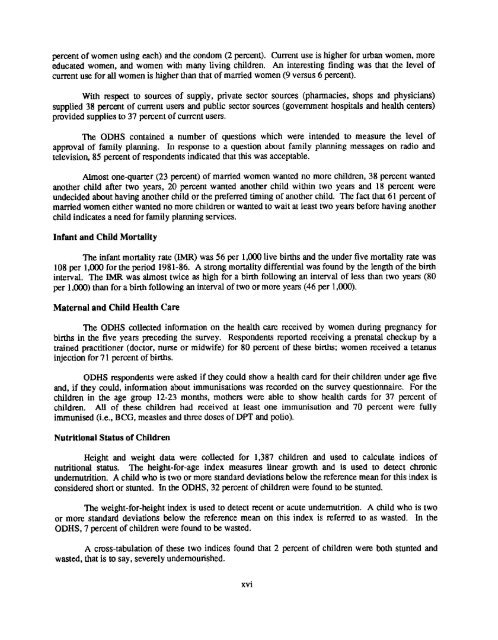Final Report (PDF, 2132K) - Measure DHS
Final Report (PDF, 2132K) - Measure DHS
Final Report (PDF, 2132K) - Measure DHS
Create successful ePaper yourself
Turn your PDF publications into a flip-book with our unique Google optimized e-Paper software.
percent of women using each) and the condom (2 percent). Current use is higher for urban women, moreeducated women, and women with many living children. An interesting finding was that the level ofcurrent use for all women is higher than that of married women (9 versus 6 percent).With respect to sources of supply, private sector sources (pharmacies, shops and physicians)supplied 38 percent of current users and public sector sources (government hospitals and health centers)provided supplies to 37 percent of current users.The O<strong>DHS</strong> contained a number of questions which were intended to measure the level ofapproval of family planning. In response to a question about family planning messages on radio andtelevision, 85 percent of respondents indicated that this was acceptable.Almost one-quarter (23 percent) of married women wanted no more children, 38 percent wantedanother child after two years, 20 percent wanted another child within two years and 18 percent wereundecided about having another child or the preferred timing of another child. The fact that 61 percent ofmarried women either wanted no more children or wanted to wait at least two years before having anotherchild indicates a need for family planning services.Infant and Child MortalityThe infant mortality rate (IMR) was 56 per 1,000 live births and the under five mortality rate was108 per 1,000 for the period 1981-86. A strong mortality differential was found by the length of the birthinterval. The IMR was almost twice as high for a birth following an interval of less than two years (80per 1,000) than for a bi~a following an interval of two or more years (46 per 1,000).Maternal and Child Health CareThe O<strong>DHS</strong> collected information on the health care received by women during pregnancy forbirths in the five years preceding the survey. Respondents reported receiving a prenatal checkup by atrained practitioner (doctor, nurse or midwife) for 80 percent of these births; women received a tetanusinjection for 71 percent of births.O<strong>DHS</strong> respondents were asked if they could show a health card for their children under age fiveand, if they could, information about immunisations was recorded on the survey questionnaire. For thechildren in the age group 12-23 months, mothers were able to show health cards for 37 percent ofchildren. All of these children had received at least one immunisation and 70 percent were fullyimmurdsed (i.e., BCG, measles and three doses of DPT and polio).Nutritional Status of ChildrenHeight and weight data were collected for 1,387 children and used to calculate indices ofnutritional status. The height-for-age index measures linear growth and is used to detect chronicundemutrition. A child who is two or more standard deviations below the reference mean for this index isconsidered short or stunted. In the O<strong>DHS</strong>, 32 percent of children were found to be stunted.The weight-for-height index is used to detect recent or acute undemutrition. A child who is twoor more standard deviations below the reference mean on this index is referred to as wasted. In theO<strong>DHS</strong>, 7 percent of children were found to be wasted.A cross-tabulation of these two indices found that 2 percent of children were both stunted andwasted, that is to say, severely undemourisbed.xvi








![Obtaining Informed Consent for HIV Testing [QRS4] - Measure DHS](https://img.yumpu.com/49850117/1/190x245/obtaining-informed-consent-for-hiv-testing-qrs4-measure-dhs.jpg?quality=85)







